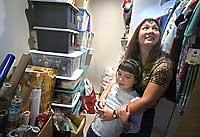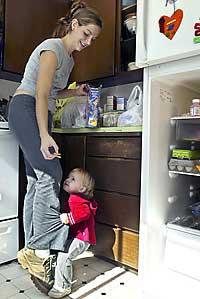Meet the bargain hunters: Three everyday experts share their tips

Think you're thrifty? Top this:
Malysa Niederkohr of Mill Creek spends $50 a week on groceries for her family of four. Including diapers.
Shelly Watanabe of Burien — a self-described "thrift queen" — once scored a $200 beaded cocktail dress for $4.99.
Mara Phipps of Bothell has a walk-in closet jammed with bargain-priced gifts: toys, 25-cent boxes of Christmas cards and 97-cent shirts from GapKids. Christmas, she says, is done — and has been since July.
Many people casually clip a coupon now and again, give the clearance rack a once-over, maybe reuse a piece of aluminum foil in a pinch.
But where many consumers surrender their scissors the minute coupon-clipping gets wearisome, "supersavers" like these three are just getting warmed up. For them, saving money is a hobby, a passion, a principle.
And for some, a necessity: A basket of goods and services that cost about $100 in the Puget Sound region in 1983 had nearly doubled to $192 last year, according to the federal Bureau of Labor Statistics.
Thriftiness is, however, a lost art for many Americans. Shoppers often pay full price for stuff they don't need, dismiss rebates as too time-consuming, and toss billions of dollars in coupons every year.
Easy credit has put more buying power in consumers' hands in the past 15 years, said Stephen Brobeck, executive director of the Consumer Federation of America. Consumer debt has grown, though savings and credit-repayment rates have crept upward in recent years.
Yet thriftiness remains "a very strong, very important value held by millions of Americans," Brobeck said.
"It's the Wal-Mart phenomenon," said Dan Geiman, a consumer analyst with Seattle investment firm McAdams Wright Ragen. "A lot of people focus on price and will go out of their way to find it — at least to some extent."
Price-conscious shoppers and competition from low-price leaders like Wal-Mart and Costco "definitely impact retailers and how they operate," Geiman said.
But the superthrifty — those who stockpile bargains by the case and hit five grocery stores a week in their quest for the best deal — are still in the minority.
Extreme savers, like these three Seattle-area women, are a cut above, Brobeck said: self-disciplined and willing to invest more time to save more money.
Living the frugal life resonates with seniors on fixed incomes whose saving habits may be ingrained from youth, single or stay-at-home parents downsizing from two incomes to one, and people drawn to the concept of the "voluntary simplicity" movement.
Supersavers get calls from their friends asking where to get the best deal on everything from Christmas trees to chicken breasts. They make their own gifts, plan dinners around what's on sale, barter and haggle even if it's on sale. They are driven by the thrill of the bargain hunt, and sometimes their strategies are a little extreme.
If the idea of shaving hundreds of dollars off your monthly expenses appeals to you, this trio of supersavers is willing to share some secret bargain-hunting haunts, practical tips and best frugal finds.
Saving for the future
Name: Malysa Niederkohr, 24, of Mill Creek
Occupation: Former body piercer, now a stay-at-home mom
Household includes: Her husband and their two young children
Hottest deal: An $800 sofa for $300 by twisting the salesman's arm
Secret weapon: Sticks to her shopping list religiously
Best time-saving tip: Cook ahead. Niederkohr recently stocked up on sale-priced chicken, then contemplated cutting and cooking it to freeze in meal-sized portions ready to be whipped into a meal.
While Niederkohr is a stay-at-home mother of two, she has a job: "My job is not to spend."
To be precise, her job is to spend wisely, and she's very good at her work. Sitting on her $300 sofa, Niederkohr is surrounded by the fruits of her labor: An oversized chair — haggled to $175 from $400. The play outfit her 3-year-old son is wearing — $2 from a thrift store. The $3.55 pork roast in the oven — on sale for half-price.
She's whittled the family grocery bill down to $50 a week, including diapers for her 16-month-old daughter, Avery. That's less than half of what the typical local household pays.
Balancing the budget begins at the kitchen table, where Niederkohr sits down for 45 minutes every week with the Sunday coupons, the grocery ads and a piece of paper.
She makes a meal plan based on what's on sale and writes down the staples her family needs. Then she adds it all up and crosses things off until she hits $50. "Our meals are pretty balanced," she said, with dinners that always include meat, two vegetables and bread.
"If pork chops are on sale, we might have them twice in a week," she said. "If Doritos are on sale but we're overbudget, we can live without Doritos."
Then on Friday mornings, she, Avery and son Luke make the rounds. First stop: the Grocery Outlet in Everett for five pounds of bananas, pizzas or a family-size box of chicken nuggets shaped like bunnies.
Then they're off to Trader Joe's for cheap snacks. Finally, she'll buy store brands at Albertsons or Safeway until she hits the $50 mark. At most stores, she's buying only a few items.
She stocked up at a recent Albertsons sale, leaving with 10 bags of groceries for $49 and change, impressing even the checker.
Niederkohr's frugal lifestyle has roots in her past but is motivated by her future.
She and her husband, John, moved here from Toledo, Ohio, 18 months ago for his job. He works as a director of sales at an Internet company in Bellevue.
When they moved, they sold the house Niederkohr bought on her own at age 19. Their mortgage quadrupled when they found a new home here, in a neighborhood of modest single-family houses between Mill Creek and Bothell.
Their plan is to save up for a home remodel that will give them more equity in the house and eventually allow them to trade up to a bigger home.
"It's not that we don't have money ... but if I don't stick to my budget, we're not going to be able to get anywhere," Niederkohr said.
Her frugality also allows her to stay home with Luke and Avery. Niederkohr quit her job as a body piercer when her children were born. "I could work, but everything I made would go for day care," she said, "and I don't want someone else raising them."
Niederkohr grew up in Toledo with two siblings and their single mother. From her mom, she learned how to make things last. Her stepmother taught her how to shop by comparing prices to get the most value.
If she thinks of buying something for herself, she'll stop and ask herself if she really needs it. Then she walks away from it for a day to think it over — even if it's a new Isaac Mizrahi purse at Goodwill, originally from Target, for $6.
Instead of buying gifts, Niederkohr makes things. She'll offer to make the birthday cake when her children's friends have parties. She'll offer a free piercing to a friend. She uses her skill as a glass artist to make glass beads and jewelry.
"Jack-of-all-trades, master of none," she laughs.
And she's not afraid to talk her way into a deal. She'll look for the last box on the shelf, and if the box is dented, she'll ask the clerk for a discount. That got her 15 percent off some Christmas gifts last year.
"Sometimes it's embarrassing, but that's how I was raised," Niederkohr said. "It doesn't hurt to ask."
Stocking up on bargains
Name: Mara Phipps, 40, of Bothell
Occupation: Fourth-grade teacher who works part time in a job-share
Household includes: Her husband and their two children
Hottest deal: Jeans at Ross Dress for Less for 49 cents — "they even came with a belt!" She bought matching pairs for her daughter and her daughter's friend.
Secret weapon: Stocks up when she finds a good deal.
Best time-saving tip: Buying ahead means you rarely run out of things, eliminating last-minute dashes to the store for a single item. Phipps writes the date of purchase on cake mixes or canned goods so she remembers to use the oldest items first.
Phipps has three pantries, two freezers and one walk-in gift closet, all stuffed with bargains.
If Phipps spies a good deal — on anything from boneless, skinless chicken breasts to trendy board shorts — she'll buy several. Her coffers are so full of good deals that she often donates the overflow to food pantries and friends.
"My husband rolls his eyes and says, 'Do you know we have 12 cans of tuna?' And I say, 'Well, yeah, they were five for $1. You think I'm going to buy them for 89 cents each?' " Phipps said. "After 20 years with me, you'd think he'd understand."
Perhaps in self-defense, her husband, Alastair, a manager of information technology in Redmond, built her some shelves that line one wall of their garage.
Inside their comfortable home, set on a wooded half-acre lot, he built her a pantry closet to supplement a cupboard pantry in the kitchen.
The well-stocked shelves would put a survivalist to shame: two dozen cans of green beans, eight boxes of brownie mix, three bottles of laundry detergent and more.
She knows her prices cold and refuses to spend more than 99 cents for a quart jar of mayonnaise or 79 cents for a bottle of ketchup. Her baseline price for a gallon of milk is $2.19 — always the same price at Rite Aid — if she can't find it cheaper elsewhere.
Her husband takes the shopping list to Costco ("I can't be trusted in there," she said), consulting Phipps by cellphone on the prices before checking out. "Costco isn't always the cheapest," she said.
Using grocery-store ads and a few coupons, Phipps spends $70 to $100 a week to feed her family of four, which includes Jana, 9, and Alex, 6. "And that's eating well," she said — lamb, steak and fresh produce.
Phipps doesn't have to live this way. She and her husband have a combined household income of $125,000. Part of it is a game that Phipps enjoys: "It's not how much you make. It's how much you save."
But her thriftiness is also a relic of her childhood. She and her three siblings grew up on a small farm on Hawaii's Big Island. Her mother was a teacher and her father was disabled.
"We were very, very poor, but we ate very well. No one knew we were poor," she said. The family lived off the land, canning or freezing fresh fruits and vegetables and slaughtering their own livestock.
Now, Phipps makes homemade jams and cans produce to give away for Christmas and special occasions in gift baskets (20 cents at a thrift store) stuffed with homemade bread and other goodies. Her garage pantry contains nearly 150 jars of fruit jam.
Upstairs, Phipps' walk-in gift closet is filled with bargains she picks up year-round by shopping after-holiday sales, clearance racks and discount retailers. Labeled bins are filled with party favors, gift bags, wrapping paper, children's books and clothes, stickers and toys.
Saving money "has to be part of your personality," Phipps said. "Most people don't have the priority to save — it's too much trouble." She was startled one day when she was having lunch with friends and learned that two of the three women didn't know how much their favorite bread cost.
Phipps believes she's passing along valuable lessons to her children. Her saving habit also helps finance trips home to Hawaii once or twice a year as well as vacations to her husband's native Australia every couple of years.
"We save for the important stuff," she said.
A compulsion to save
Name: Shelly Watanabe, 41, of Burien
Occupation: Financial-service specialist with the state Department of Social and Health Services
Household includes: Her partner and two children
Hottest deal: Black knit cocktail dress, regularly $200, on sale at Nordstrom Rack for $4.99
Secret weapon: "I know my prices and my brands. I know what a good deal looks like."
Best time-saving tip: Watanabe takes all of her coupons to Albertsons because they honor competitors' coupons.
Watanabe is not so much thrifty as she is dogged in her pursuit of a bargain. She shops about four days out of seven.
She hits as many as four grocery stores a week on her one-hour lunch break (all within a couple miles of her job at the Department of Social and Health Services office in White Center). She keeps a cooler in her car trunk to hold the perishables until she gets home.
Between coupon-clipping, list-making and shopping, she spends two and a half hours and $150 a week getting food and household supplies for her family: her partner, James, a steelworker; 15-year-old Alicia; and 2-year-old Frankie.
That's higher than the $100-a-week grocery bill of a typical American household. She said it includes diapers, toiletries, laundry soap and lots of meat because James "is a meat-and-potatoes man."
Watanabe really gets going on the weekends.
She drives from her home in Burien to Kent almost every Saturday to drop off a load of clothes at a consignment store, then hits a couple of her favorite outlet stores, including Stupid Prices. The outlet charges no sales tax and sells overstocked items, demos and returns from other retailers. She once got six Costco-sized double boxes of cereal for $4.50.
Mondays are 99-cent days at St. Vincent de Paul. Thursday, it's 50 percent off color-coded tags at Value Village.
She is perhaps a little too good at spotting a deal.
"It's almost compulsive. It's almost a sickness," said Watanabe, who has a combined annual household income of $35,000.
It's also hereditary, Watanabe believes. She comes from a long line of thrifty shoppers, including her dad, who stocks up by the case when he spots a deal.
"I learned the value of a dollar early," said Watanabe, who was living on her own at age 17.
Watanabe starts her grocery shopping by clipping coupons — she'll use 10 to 15 per grocery-store trip, including double manufacturer coupons she collects from friends who don't clip coupons. That's how she recently scored two 12-packs of soda for $3.
Then she studies the grocery-store ads that come in the mail. She'll write down the best buys, check her stack of coupons and write a "C" next to the item if she finds a coupon.
One of her more extreme habits: shopping the reduced-price meat bin for meat near its expiration date. "Maybe it's a little brown," Watanabe said, "but sometimes it just has more flavor."
It's a "cheap thrill," Watanabe said, saving up to 60 percent off her grocery bill. "What I'm saving here is to make up for spending more elsewhere."
Jolayne Houtz: 206-464-3122, jhoutz@seattletimes.com
Times researcher Gene Balk contributed to this report.


|